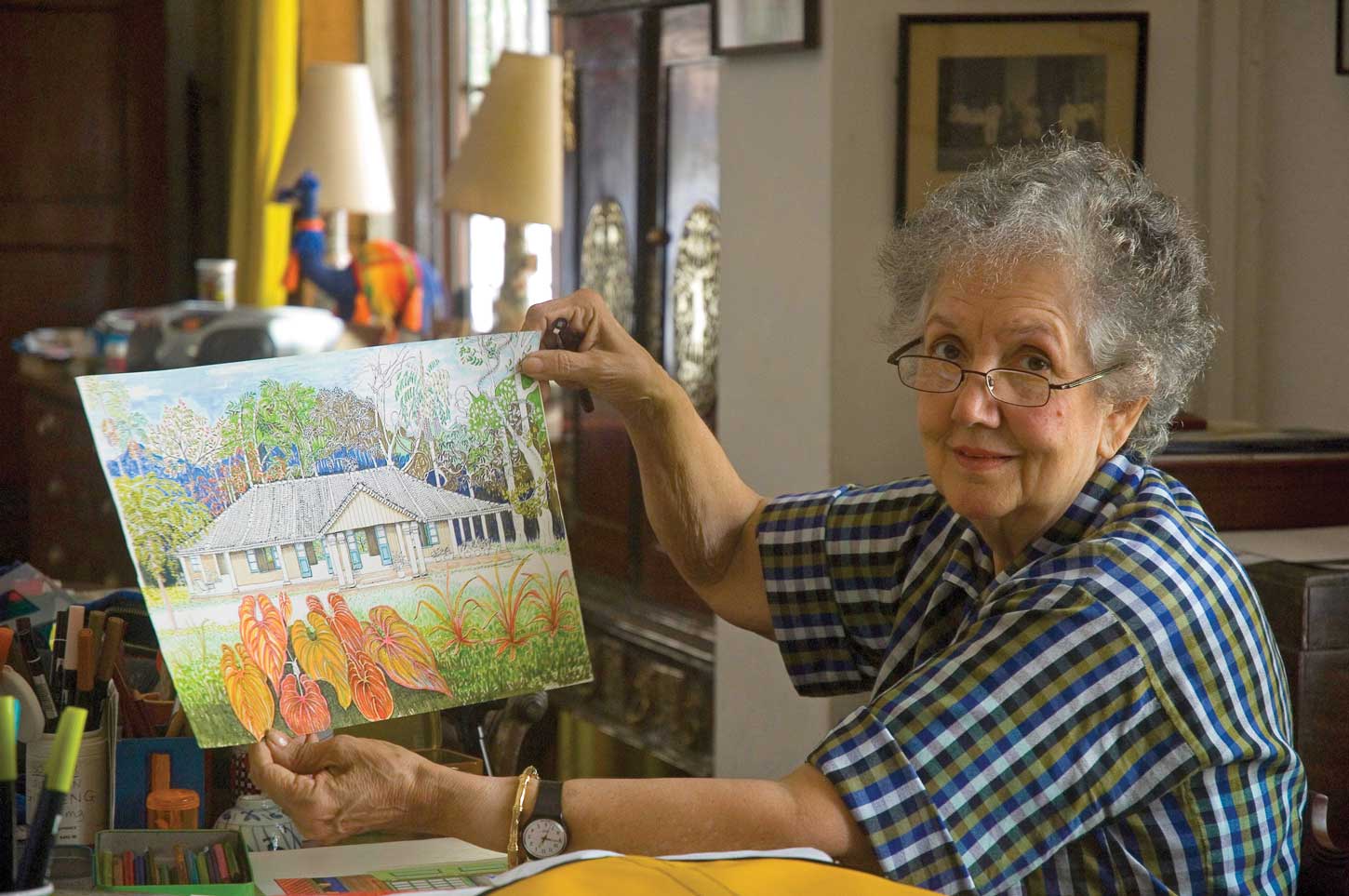A LIFE IN COLOUR
BY David Robson
Barbara Sansoni died in April at her home in Colombo after a long illness. She was the last surviving member of a pioneering group of creative designers and makers, among them Bevis and Geoffrey Bawa, Ena de Silva and Laki Senanayake. They were born during the final decades of the British colonial period and sprang forth like uncoiled springs after Ceylon regained independence.
She was born in Kandy in1928. Her father Rex Daniel was in the Ceylon Civil Service and the family lived in a series of colonial bungalows in different parts of the island. When she was 11, Barbara was sent to a Catholic convent boarding school in South India. And after WWII she moved to London and studied at the Chelsea College of Arts for four years. Upon returning to Ceylon, she married Hildon Sansoni – a naval officer and a former aide-de-camp to the British Governor.
Her involvement in weaving began after the birth of her two sons. In 1960, the nuns of the Good Shepherd Convent began a weaving centre at Nayakakanda to the north of Colombo. This was part of a programme to help women and it was run by an Irish nun called Mother Good Counsel. It was she who persuaded Barbara to work with them as a designer. She said: “You will ensure that they never make anything ugly and that their work will be their pleasure and joy.”
Barbara started to experiment with colour and developed new weaving patterns inspired by the landscape, fauna and flora of the island.
After 1960, she worked with rural weaving cooperatives and sold fabric from her home in Anderson Road under the brand Barbara Sansoni Fabrics. In 1970, she opened two shops: one in Fort called House, which specialised in household fabrics and the other at Galle Face Court. It was called Barefoot and the shop sold clothes.
Inspired perhaps by memories of her peripatetic childhood, Barbara developed an interest in the traditional architecture of Ceylon and teamed up with architect Ulrik Plesner and artists Laki Senanayake and Ismeth Raheem, to record examples of buildings from different periods. This led her to write a series of newspaper articles that broadcast details of a forgotten heritage, which was at risk of disappearing.
She also began to work collaboratively with architects and contributed terra cotta ‘Stations of the Cross’ to Geoffrey Bawa’s convent chapel in Bandarawela and developed colour schemes for the SOS Children’s Villages that were designed by architect C. Anjalendran.
The 1970s witnessed an influx of tourists and many hotels used Sansoni fabrics for their table linen and soft furnishings. Her vibrant colours and strong designs made a big impact and many visitors returned home with her fabrics, clothes, bags and toys.
Hildon Sansoni died in 1979 and his place at Barefoot was taken by his son Dominic – a photographer.
In 1983, Barbara married architectural historian Ronald Lewcock and it was he who persuaded her to publish the marvellous book titled: Architecture of an Island. His texts amplified the huge collection of drawings that she and Laki Senanayake had produced.
Barefoot became a multifaceted organisation that exported its unique range of artefacts to countries around the world. The shop in Galle Road grew to include a bookshop, an art gallery and a lively outdoor cafe. More than simply a shop, it became a place where people could meet to eat and drink, listen to live jazz, look at the work of up-and-coming artists and talk.
Barbara Sansoni didn’t invent colour in Ceylon – it was always there, hidden in the shadows cast by more than four centuries of colonial hegemony. But she certainly opened everyone’s eyes to it! Her brightly woven handlooms were a revelation and made a huge impact on a new generation of Sri Lankans.
When Barefoot held an exhibition in 2004 to celebrate 40 years of design, Barbara described how her colour sense was heightened by her experience of living in Sri Lanka. She demonstrated with paired images how her colour combinations were inspired by nature.
Barbara was a larger-than-life character – a woman of strong opinions who would always stand out in a crowd. Much of what she did was groundbreaking but she was so successful that her ideas were eventually absorbed into the mainstream and lost their power to shock.
It is easy now to forget the impact that her startlingly new designs had on Colombo in the 1970s. Barefoot exerted a huge influence on how a new generation of Sri Lankans saw themselves, dressed themselves and lived their lives.
This slideshow requires JavaScript.




